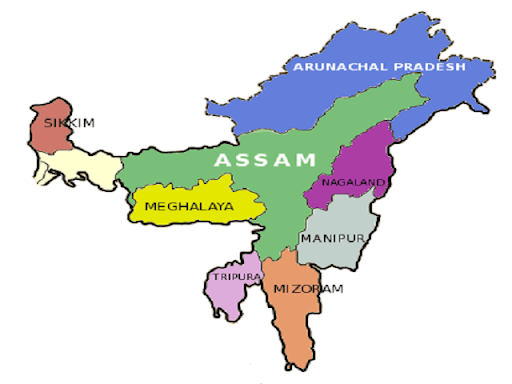Naga Ceasefire Agreements Extended | 21 Apr 2022
For Prelims: Naga Ceasefire Agreements, Naga peace process, Karbi Anglong Agreement, 2021, Bru Accord, 2020, Bodo Peace Accord, 2020, Citizenship (Amendment) Act, 2019, National Register of Citizens
For Mains: Importance of Vision of Insurgency Free, Prosperous North East, Status of Conflicts in Northeast India
Why in News?
Recently, the centre has extended the ceasefire agreements between the Central government and three Naga groups by a year which was signed on 19th April 2022.
What are the Naga Ceasefire Agreements?
- The Naga groups include National Socialist Council of Nagaland-NK (NSCN-NK), National Socialist Council of Nagaland-Reformation (NSCN-R) and National Socialist Council of Nagaland-K-Khango (NSCN-K-Khango).
- All these groups are breakaway factions of National Socialist Council of Nagaland (NSCN-IM) and National Socialist Council of Nagaland-Khaplang (NSCN-K).
- This agreement is a significant boost to the Naga peace process and in line with Prime Minister of India's vision of 'insurgency free, prosperous North East'.
- In September 2021, the Centre had entered into a one-year ceasefire agreement with the National Socialist Council of Nagaland (K) Niki Group.
- The Centre had earlier signed a “Framework Agreement” with the NSCN (IM) in August 2015.
What is the Naga Peace Process?
- After India became independent in 1947, the Naga territory initially remained a part of Assam.
- In 1957, after an agreement was reached between Naga leaders and the Indian government, the Naga Hills region of Assam and the Tuensang frontier division to the northeast were brought together under a single unit directly administered by the Indian government.
- Nagaland achieved statehood in 1963, however, rebel activity continued.
What is the Vision of Insurgency Free, Prosperous North East?
- Recognises that the North East is very important for the country from the aspects of security.
- Thus, the aim is to end all disputes in the Northeast by 2022 and usher in a new era of peace and development in the Northeast in 2023.
- Under this, the Government is enriching the dignity, culture, language, literature and music of the Northeast.
- Over the years, the government has also signed several peace agreements with military outfits in northeast India. For example,
- Karbi Anglong Agreement, 2021: It involved a tripartite agreement signed among five insurgent groups of Assam, the Centre and the state government of Assam.
- Bru Accord, 2020: Under the Bru accord, the permanent settlement of 6959 Bru families in Tripura with a financial package has been agreed between the Government of India, Tripura and Mizoram with representatives of Bru migrants.
- Bodo Peace Accord, 2020: In 2020, the Government of India, Government of Assam and representatives of Bodo groups signed an agreement, wherein more autonomy is provided to Bodoland Territorial Region (BTR), in Assam.
- Peace agreement with various military outfits which are involved in Naga Insurgency like NSCN(NK), NSCN(R), and NSCN(K)-Khango, NSCN(IM).
What is the Status of Conflicts in Northeast India?
- National Conflicts: Involving the concept of a distinct ‘homeland’ as a separate nation.
- Nagaland: Naga insurgency originated from the demand of independence.
- Although the demand for independence has majorly subsided, the lingering issue of a final political settlement including the demand for ‘greater Nagaland’ or ‘Nagalim’ remains.
- Nagaland: Naga insurgency originated from the demand of independence.
- Ethnic Conflicts: Involving assertion of numerically smaller and less dominant tribal groups against the political and cultural hold of the dominant tribal group.
- Tripura: The State’s demographic profile has been altered since 1947 when mass migrations from the newly emerged East Pakistan converted it from a largely tribal area to one with a majority of Bengali speaking people.
- Tribals were deprived of their agricultural lands at throw-away prices and driven to the forests.
- The resultant tensions caused major violence and widespread terror.
- Tripura: The State’s demographic profile has been altered since 1947 when mass migrations from the newly emerged East Pakistan converted it from a largely tribal area to one with a majority of Bengali speaking people.
- Sub-regional Conflicts: Involving movements which ask for recognition of sub-regional aspirations and often come in direct conflict with the State Governments or even the autonomous Councils.
- Mizoram: The State with its history of violent insurgency and its subsequent return to peace is an example to all other violence affected States.
- Following an ‘Mizo Peace accord’ between the Union Government and the Mizo National Front in 1986 and conferment of statehood the next year, complete peace and harmony prevails in Mizoram.
- Further, the boundary issue between Assam and Mizoram has existed since the formation of Mizoram.
- Mizoram: The State with its history of violent insurgency and its subsequent return to peace is an example to all other violence affected States.
- Other Reasons: Sponsored terrorism, conflicts generated as a result of continuous inflow of migrants from across the borders, criminal enterprise aimed at expanding and consolidating control over critical economic resources, have also result into clashes.
- Assam: The major ethnic conflict in the State is the grievance against the perceived influx of ‘foreigners’ i.e. people with a language and culture substantially different from the Assamese from across the border (i.e. Bangladesh).
- The recent tension in Assam emanates from the Citizenship (Amendment) Act, 2019 and National Register of Citizens debate.
- Assam: The major ethnic conflict in the State is the grievance against the perceived influx of ‘foreigners’ i.e. people with a language and culture substantially different from the Assamese from across the border (i.e. Bangladesh).
What are the Different Modes of Conflict Resolution?
- Strengthening security forces/ ‘police action’.
- More local autonomy through mechanisms such as conferment of Statehood, the Sixth Schedule, Special Provisions under PART XXI of the Constitution.
- Negotiations with insurgent outfits.
- Development activities including special economic packages.


